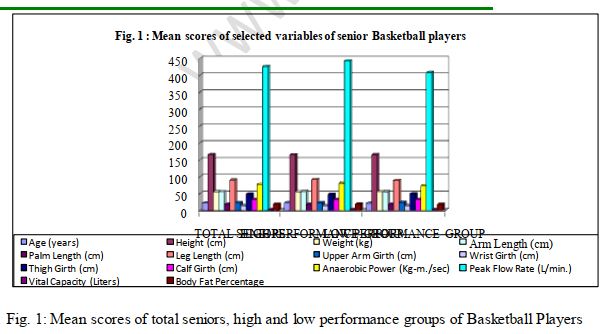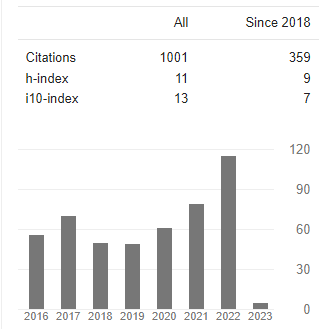DIFFERENTIATION OF SELECTED ANTHROPOMETRIC AND PHYSIOLOGICAL VARIABLES IN HIGH AND LOW PERFORMANCE GROUPS OF BASKETBALL PLAYERS
Abstract
The study sought to differentiate the selected anthropometric and physiological measures in high and low performance groups in senior female Indian basketball players. The study measured anthropometric measures (height, weight, arm length, palm length, leg length, girths of the upper arm, wrist, thigh and calf and skin folds at biceps, triceps, sub scapular and suprailiac) and physiological variables (anaerobic power, peak flow rate, vital capacity and BF% ) of 96 female players competing at the Senior National Basketball Championship. The high and low performance groups divided according to the team performance in the championship. The first four teams were called the high performance group (HPG) and the remaining four teams were placed in low performance group (LPG). To collect the data of selected variables were taken on each subject individually during rest hours with the help of standard scientific instrument and under scientific guidelines. Significant differences were found in HPG and LPG in relation to age (2.387*), leg length (1.991*), thigh girth (2.641*), anaerobic power (3.463*), peak flow rate (2.193*), vital capacity (3.011*) and body fat% (2.240*). On the basis of the results, it was concluded that the significant anthropometric measures i.e. palm length, leg length, upper arm girth, thigh girth and physiological distinctiveness such as anaerobic power, peak flow rate, vital capacity and BF% highly contributed to performance in Basketball.
Downloads
References
Angyan, L., Teczely, T., Zalay, Z., & Karsai, I. (2003). Relationship of anthropometrical, physiological and motor attributes to sport-specific skills. Acta Physiologica Hungarica 90 (3), 225-231.
Baechle, T.R. (1994). Essentials of strength training and conditioning. Champaign: Human kinetics.
Cureton, M. (1951). Physical fitness of Champion athletes. Urbana: The University of Illinois Press.
Fox, E.L., & Mathew, D.K. (1985). The Physiological basis of Physical Education and Athletics. New York: Sounders College Publishing Comp.
Ghosh, A.K., Khanna, G.L., & Ahuja, A. (1984). Pulmonary capacities of sportsmen involved in ball games. Society of National Institute of Physical Education & Sports Journal 7 (1), 96-101.
Grewal, R. (1983). Physique and body composition of Indian sports women with special reference to their participation. Unpublished Ph.D. Thesis, Patiala: Panjabi University.
Januszewski, M. (2010). mJanuszewski.files.wordpress.com/2010/the-physiology-of-basketball.
Lohman T.G., Roche, A.F. & Martorell, R. (1991). Anthropometrical Standardization. Reference Manual. Champiogn: Human Kinetics.
Mokha, R., & Sidhu, L.S. (1987). Body fat in various sportive groups. Journal of Sports Medicine 376- 378.
Singh, B. (1994). Physiological variables as predictors of performance in Basketball. Unpublished Thesis, Patiala: Punjabi University.
Soares, J., Mendes, O.C., Neto, C.B. & Matsudo, V.K.R. (1986). Physical fitness characteristics of Brazilian national basketball team as related to game functions. In J.A.P. Day (Ed.), Perspectives in Kinanthropometry. Human Kinetics, Champaign, 127–133.
Sodhi, H.S. (1991). Sports Anthropometry- A Kinanthropometric approach. Mohali: Anova Publication.
Sodhi, H.S., & Sidhu, L.S. (1984). Physique and selection of Sportsmen. Patiala: Punjab Publishing House.
Vaeyens R., Lenoir, M., William, A.M., Philippaerts, R.M. (2008). Talent Identification and Development Programmes in Sport Current Models and Future Directions. Sports Med 38 (9), 703- 714.
Voccaro, P., Clarke, D.H., Wrenn, J.P. (1997). Physiological Profiles of Elite Women basketball players. Journal of Sports Medicine 19, 45-54.















